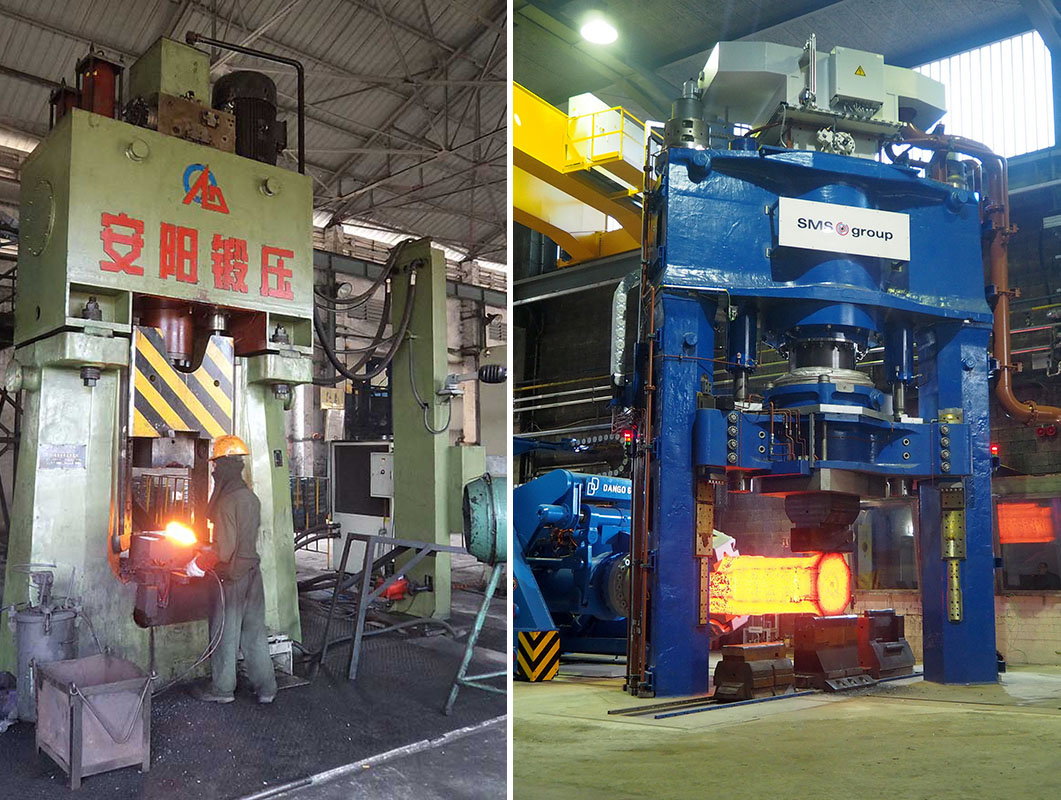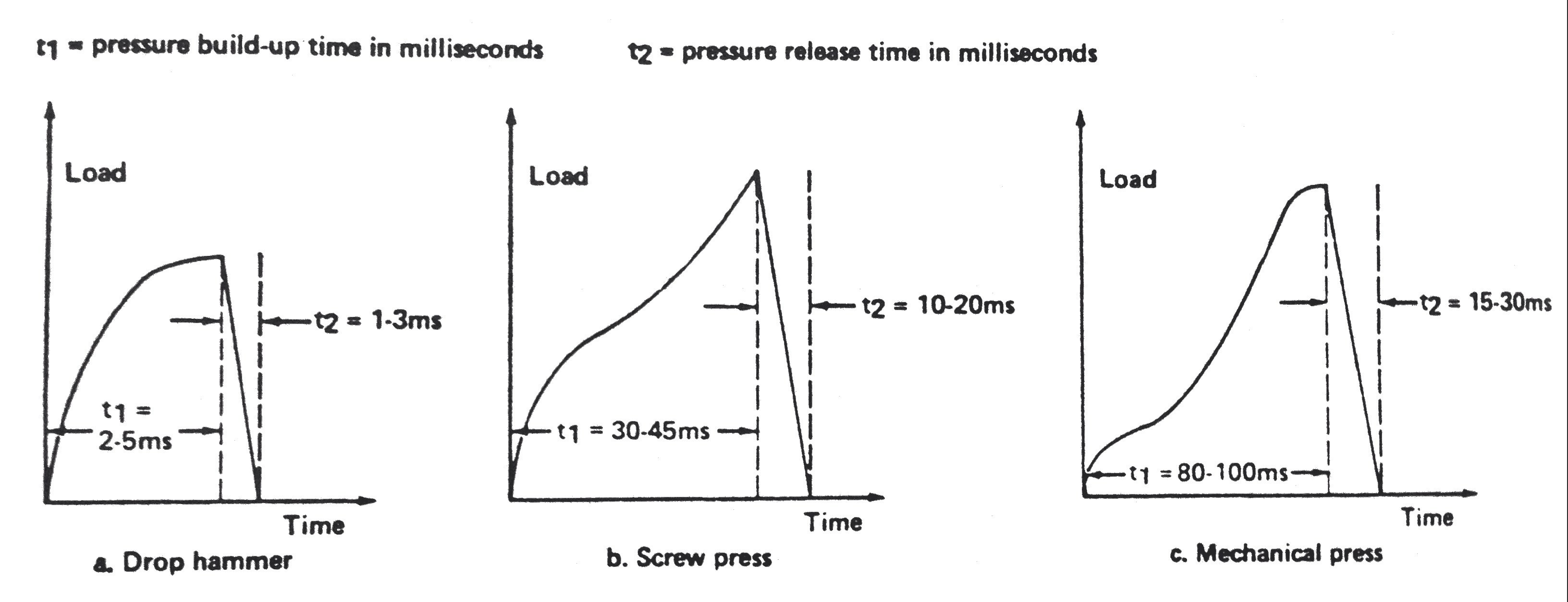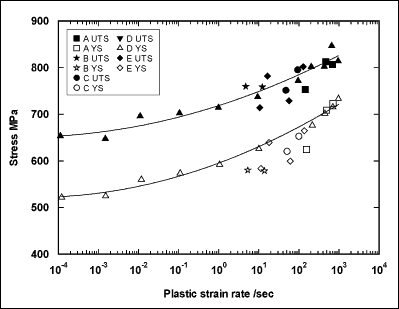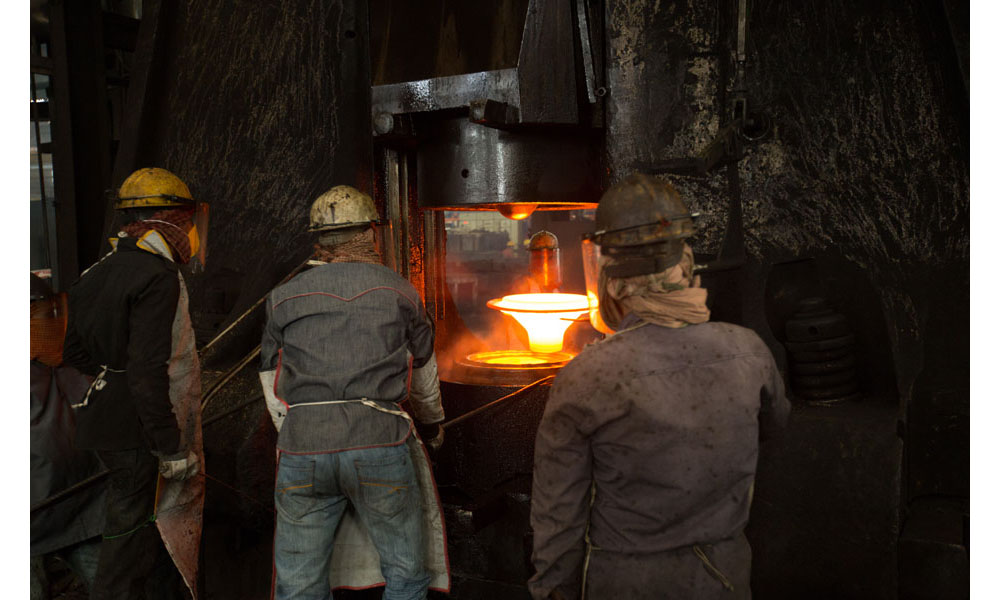Differences between Drop Forging and Press Forging
The biggest main difference between the two techniques is the deformation speed with all the implications that this has on the formability of the material and on the processing. Drop hammers reach peak loads in 2-5 ms while press forging, which is usually executed with screw presses or mechanical presses, have maximum peak force between 30 to 100 ms.

Differences between Drop Forging and Press Forging
Metal forging is the method of manipulating metal into a certain shape. This is commonly done through one of two methods, drop forging and press forging.
Drop Forging – With drop forging (also called hammer forging), the metal billet is inserted into the die and hammered with multiple blows. This process continues the billet is shaped into form. Drop forging can be operated both at high or room temperatures, and tongs are generally required.
During this process, the surface layers of the metal are manipulated into shape. However, the center area of the metal will stay relatively un-deformed. Draft angles are often utilized more in this process than with press forging. The initial cost set up is also less than that of press forging, but production rates can become more costly as volume increases.
Press Forging – uses a slower and continuous pressure to shape metal into a certain shape. So instead of using multiple hammer blows to manipulate the billet, this method uses a singular compression. Like hammer forging, press forging can also be done at high or low temperatures.
With press forging, the metal is shaped in a uniform way from the surface to the center. This means the impressions created are cleaned and the end product is generally stronger. Tongs are usually not required, and draft angles are not as frequently used. Initial setup costs are also higher with press forging, but the method becomes more cost effective as volume increases.
Advantages and Disadvantages
Pros of Hammer Forging
– Lower initial setup costs
– Faster process
Cons of Hammer Forging
– Only shapes the surface of the workpiece
– Strain rate more difficult to control
Pros of Press Forging
– More cost effective for higher volume runs
– Deforms the complete workpiece (not just the surface)
– Strain rate can be controlled easier
Cons of Press Forging
– Higher setup costs
– More time-consuming process
The biggest main difference between the two techniques is the deformation speed (see image below, taken from Powder Forging: Howard A. Kuhn, B. Lynn Ferguson) with all the implications that this has on the formability of the material and on the processing.
Drop hammers reach peak loads in 2-5 ms while press forging, which is usually executed with screw presses or mechanical presses, have maximum peak force between 30 to 100 ms.

Yield strength, being a thermally activated process, changes with strain rate (deformation speed). The image below is for a 20MnMoNi55 steel. As you can see when you increase the speed the material reacts with a higher yield strength and ultimate tensile strength (UTS). Thus with press forging you would need lower forces to accomplish the feat of deforming the piece in the mould whereas hammer forging usually requires multiple hits/blows to fill the moulds.

The remaining differences are a pure consequence:
Drop hammers employ operators and are not automatized - the choice of how many blows and with what intensity is based on the operator's experience (with all the advantages and disadvantages that this brings along).
Drop hammers are less safe - since the operator requires visual contact barriers are uncommon and hot steel/oxide splinters are always sent dashing thorough the production warehouses (seems odd in 2016 but yes, that's how it still is); in addition given the high speeds when fractures in mould occur it can become a big mess.
Drop forging is more prone to problems from operators and variabilities in the product.
Drop forging is very effective in breaking large internal inclusions.
Modern screw presses are frequently automatized - the stroke is controlled and selected in the set up of the process, the remaining efforts are easy automation and process control.
Screw presses are more reliable.
Large parts require huge presses but only large drop hammers - since drop hammers are fast multiple blows are possible so larger parts can be shaped, to obtain the same result with a screw press you need a much larger and complicated system.
Presses are more versatile than drop hammers - you can use them for closed die forging, open die forging and shaping while drop hammers can be used only for closed die forging.
Drop Forging:
It utilizes a closed impression die to obtain the desired shape of the component. The shaping is done by the repeated hammering given to the material in the die cavity. The equipment used for producing the blows are called drop hammers. In general drop forging will be done in two halves of the dies. The bottom half of the die is fixed to the anvil of the machine but the upper half of the is fixed to the anvil of the machine but the upper half of the is fixed on the heated stock is kept in the bottom die and the top die or ram delivers few numbers of blows on the metal. Die impressions are machined in the cavity, hence some complex shapes can be produced. But too much complex shapes cannot be produced like cavities, deep pockets etc due to the limitation of withdrawal of finished forging. The products produced are crankshaft, crank, connecting rod, crane hook, wrench etc.
Press Forging:
The process of producing the shape of the component sis similar to that of the drop forging but in press forging the required amount of force can be obtained continuously in the squeezing action. This squeezing is obtained by means of a hydraulic press or mechanical press. Because of continuous force application, the material gets uniformly deformed throughout the its depth.
Differences between the Drop and Press Forging:
- The more hammer force is likely to be transferred to the machine frame in drop forging but in press forging the force is transmitted to the stock.
- The impression obtained in press forging is clean compared to the drop forging in which likely jarred impression is produced.
- Draft angle used in press forging is less than the drop forging.
- For the same amount of deformation to be produced, the force required in press forging is higher than the drop hammer forging.

